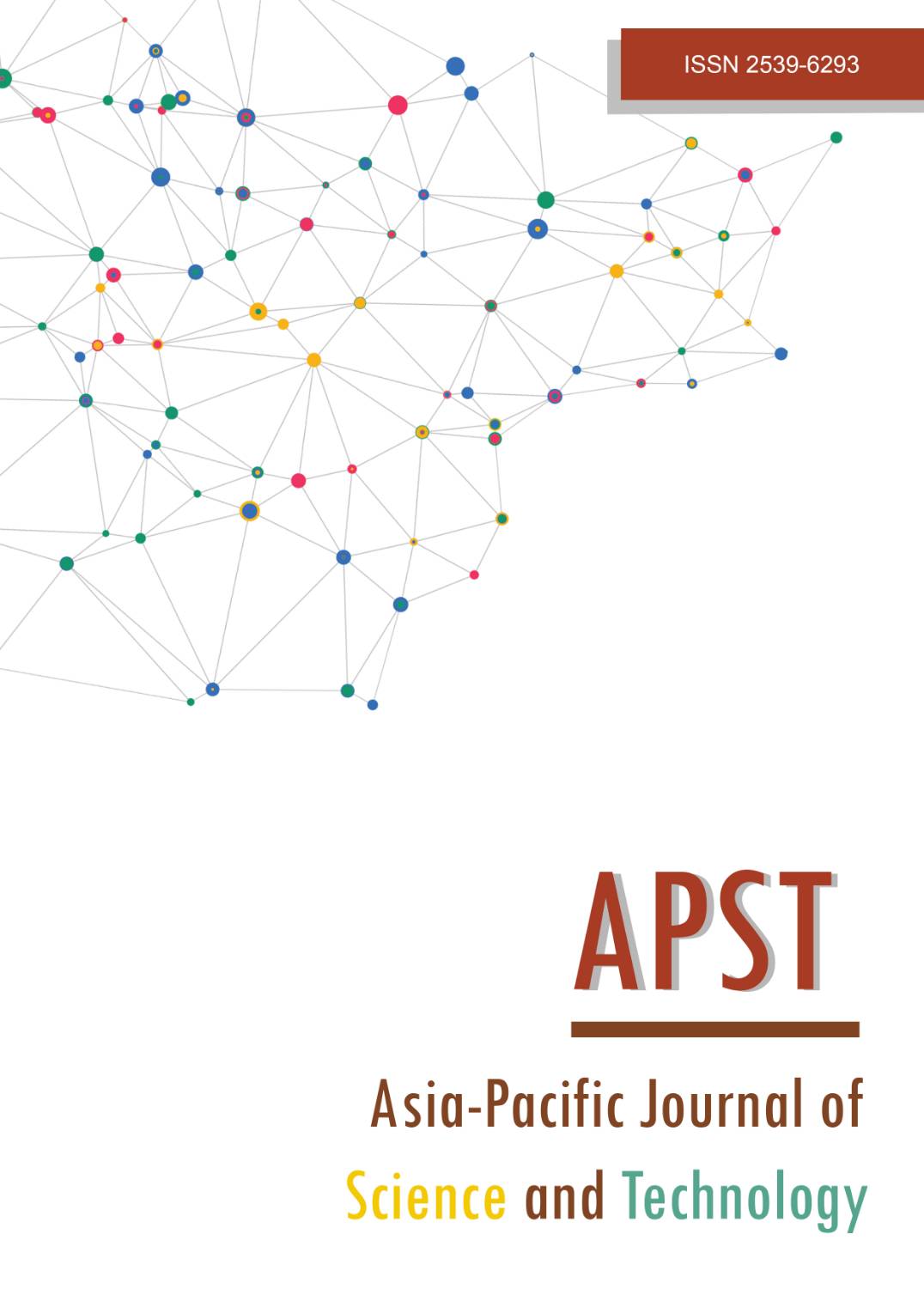Improving properties of modified silica by admicellar polymerization technique for inner rubber tube products
Main Article Content
Abstract
Modified silica using admicellar polymerization technique (APT) has shown to effectively reinforce natural rubber products. The study has shown that reinforcing natural rubber with APT-modified silica at the 40 phr yields excellent mechanical and ozone aging resistant properties. For the 40 parts per hundred of rubber (phr) sample, the cure time was found to be 138.23 ± 1.06 s. The tensile strength, the 300% modulus and the tear strength were 21.55 ± 0.40 Megapascal (MPa), 4.62 ± 0.17 MPa and 73.67 ± 1.58 MPa, respectively. The elongation at break was measured to be 579.96 ± 6.70%. The hardness was 55.33 ± 1.15 shore A. These surpass the standard values for motorcycle and bicycle rubber inner tube products, according to the Thai Industrial Standard (TIS) 683-2530 and TIS 652-2529. Scanning electron microscopy studies revealed that their outstanding mechanical properties were related to the better adhesion between the silica particles and the rubber matrix, resulting from the thermal admicellar polymerization process. The minimal cracks observed after the ozone aging resistance test also suggest high durability.
Article Details
References
[2] Faklek A, Pongprayoon T. Development of commercial bicycle and motorcycle inner tube using surface modified silica [Dissertation]. Bangkok: King Mongkut’s University of Technology North Bangkok; 2017.
[3] Rassamee W, Thaijaroen W, Pongprayoon T. Mechanical and dynamic properties of silica-filled rubber compounds. Adv Mat Res. 2013;781-784:475-478.
[4] Kaewsakul W, Sahakaro K, Dierkes WK, Noordermeer JWM. Optimization of mixing conditions for silica-reinforced natural rubber tire tread compounds. Rubber Chem Technol. 2012;85:277-294.
[5] Luginsland D, Fröhlich J, Wehmeier A. Influence of different silanes on the reinforcement of silica-filled rubber compounds. Rubber Chem Technol. 2002;75:563-579.
[6] Toh-ae P, Pongprayoon T, Lopattananon N, Sahakaro K. Reinforcing efficiency of admicellar polymerization surface modified silica in natural rubber compounds [Dissertation]. Songkla: Prince of Songkla University; 2013.
[7] Toh-ae P, Pongprayoon T, Lopattananon N, Sahakaro K. Comparison of properties of admicellar polymerization surface modified silica and conventional fillers-reinforced tyre tread compounds. Asian J Chem. 2013;25:5226-5232.
[8] Jengyue Wu, Jeffrey H, O’Rear A. Two-dimensional solvents: kinetics of styrene polymerization in admicelles at or near saturation. J Phys Chem. 1987; 91:623-634.
[9] Kitiyanan B, O’Haver, Harwell JH, Osuwan JH. Adsolubilization of styrene and isoprene into cetyltrimethyl ammonium bromide admicelle on precipitated silica. Langmuir. 1996;12: 2162-2168.
[10] Thammathadanukul V, O’Haver, Harwell JH, Osuwan JH, Na-Ranong N, Waddell WH, Comparison of rubber reinforcement using various surface thermal APT. Appl Polym Sci. 1996;59:1741-1750.
[11] Nontasorn P, Chavadej S, Rangsunvigit P, O’Haver JH, Chaisirimahamorakot S, Na-Ranong N. Admicellar polymerization modified silica via a continuous stirred tank reactor system: comparative properties of rubber compounding. Chem Eng. 2005;108:213-218.
[12] Hayakawa K, Kawase K, Matsuda T. Gamma-ray-induced polymerization of some vinyltin compounds. Nature. 1965;206:1038-1039.
[13] Alkassiri H. Radiation polymerization of diethyl fumarate. Radiat Phys Chem. 2005;73:61-63.
[14] Yaodong L, Guozhong W, Dewu L, Mingying Q, Zhiyong Z. 60Co γ-irradiation initiated polymerization in ionic liquids-the effect of carbon-chain length of monomer. Nucl Instrum Methods. 2005;236:443-448.
[15] Cataldo F, Ursini O, Lilla EJ. Radiation induced polymerization of isoprene: a spectroscopic study. J Radioanal Nucl Ch. 2008;275:9-16.
[16] Cataldo F, Ursini O, Lilla EJ. Radiation-induced polymerization and grafting of β(-) pinene on surface of silica. Radiat Phys Chem. 2008;77:561-570.
[17] Rangsunvigit P, Imsawatgul P, Na-Ranong N, O’Haver JH, Chavadej S. Mixed surfactants for silica surface modification by admicellar polymerization using a continuous stirred tank reactor. Chem Eng. 2008;136:288-294.
[18] Nummeechai S, Suwanmala P, Hemvichian K, Pongprayoon T. Ultrathin film formation by gamma-ray induced polymerization in surfactant emplate on solid surface. Sci Tech. 2008;54:270-280.
[19] Yooprasert N, Pongprayoon T, Suwanmala P, Hemvichian K, Tumcharern G. Radiation-induced admicellar polymerization of isoprene on silica: effects of surfactant’s chain length. Chem Eng. 2010,156:193-199.


